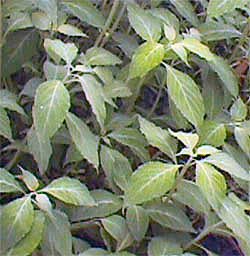 |
| Salvia divinorum |
The plant Salvia divinorum has a long and continuing tradition of use by Mazatec shamans, who drink it, sometimes followed by a drink of tequila, to induce visionary states during healing sessions, which are performed at night in a quiet and darkened room. The drink is made by crushing the leaves to extract the juices, which are then mixed with water. It is important to be ritually mindful when collecting the leaves, and there are strict prohibitions — for example, avoiding sexual contact — to be kept for several days after the ceremony. The plant grows primarily in the mountain cloud forest in Oaxaca, Mexico. There is reason to believe that the plant is either a cultigen or hybrid developed specifically for its psychoactive effects.
The primary psychoactive constituent is a diterpenoid known as salvinorin A, a potent and selective κ-opioid receptor agonist. These receptors are widely distributed in the brain, spinal cord, and pain neurons. Other drugs that act at the κ-opioid receptor, such as ketazocine, produce similar effects. Salvinorin A is unique in being the only naturally occurring substance known to induce a visionary state by acting at this site. There is no evidence that Salvia is addictive.
 |
| R. Gordon Wasson, A young Mazatec girl grinding Salvia divinorum leaves on a metate to express the juice (1962) |
Salvia divinorum can also be chewed, smoked, or taken as a tincture. Different preparations may have different onset times, but the effects and their duration appear similar — perceptions of bright lights, vivid colors and shapes, as well as body movements and body or object distortions. Other effects include dysphoria, uncontrolled laughter, a sense of loss of body, overlapping realities, and hallucinations. Adverse physical effects may include incoordination, dizziness, and slurred speech. The duration of these effects is relatively brief, typically lasting only a few minutes.
The most commonly reported aftereffects include improved mood and sensations of insight, calmness, and connection with nature. There have been rare reports of anxiety or sadness.
The Mazatec believe that Salvia is an incarnation of the Virgin Mary, and they refer to it as ska María Pastora, the leaf of Mary the Shepherdess. The name is usually shortened to ska María or ska Pastora. “The purpose of these sacraments is to purify, and to open the road,” says Mazatec shaman Aurelia Aurora Catarino. “When it opens, it’s as clear as the blue sky, and the stars at night are as bright as suns.”
In the September 2006 issue of New Scientist, writer Gaia Vince says that Salvia “took me on a consciousness-expanding journey unlike any other I have ever experienced. ” He continues:
My body felt disconnected from “me” and objects and people appeared cartoonish, surreal and marvellous. Then, as suddenly as it had began, it was over. The visions vanished and I was back in my bedroom. I spoke to my “sitter” — the friend who was watching over me, as recommended on the packaging — but my mouth was awkward and clumsy. When I attempted to stand my coordination was off. Within a couple of minutes, however, I was fine and clear-headed, though dripping with sweat. The whole experience had lasted less than 5 minutes.
Poet Dale Pendell, in the Salvia divinorum chapter of his book Pharmako/poeia, quotes some users who have smoked dried Salvia leaves: “It’s very intense, I call it a reality stutter, or a reality strobing,” says one report. And another: “It’s like heavy zazen, like after a very long period of sitting, the place you can get to there. It’s changed my life, turned my life around.”
 |
| Two Guyz Trippin on Salvia at the Same Time (2009) |
Popular use of Salvia, especially among young people, has been increasing. A National Survey on Drug Use and Health Report published in February 2008 estimated that 1.8 million persons aged 12 or older had used Salvia divinorum in their lifetime, and approximately 750,000 had done so in the past year. As we have mentioned here, the plant is being made illegal in an increasing number of states, and — while not currently regulated by the federal Controlled Substances Act — the DEA has listed Salvia as a “drug of concern.” The legal situation has been aggravated by a number of YouTube videos of teenagers, allegedly high on Salvia, laughing uncontrollably and apparently unable to perform simple tasks or to communicate.
Now the prestigious and generally sober Scientific American has published, in its August 2009 issue, an article by science writer David Jay Brown, calling for restraint in the march toward legal prohibition of Salvia. The article points out that only two labs currently conduct human studies with salvinorin A — one run by psychiatric researchers Deepak Cyril D’Souza and Mohini Ranganathan, both at the Yale University School of Medicine, and the other by pharmacologist John Mendelson of the University of California, San Francisco. Both groups are performing preliminary tests to determine how best to administer salvinorin A to human volunteers and collect basic data. The article states:
The unusual properties of salvinorin A intrigue scientists. Psychiatric researcher Bruce Cohen and his colleagues at Harvard Medical School have been developing analogues of salvinorin A and studying their possible mood-modulating properties. The team’s work with salvinorin A in animals suggests “that a drug that would block kappa opioid receptors might be an antidepressant drug — probably a nonaddictive one — or a mood stabilizer for patients with bipolar disorder,” Cohen remarks. By activating the kappa opioid receptors, drugs such as salvinorin A could reduce dependence on stimulants and the mood-elevating and mood-rewarding effects of cocaine. Because salvinorin A can produce distortions of thinking and perception, researchers speculate that blocking the receptors might alleviate some symptoms of psychoses and dissociative disorders.
D’Souza and Ranganathan argue that scheduling the drug should wait until evidence about its effects and toxicity becomes clear. “The issue is a serious one, with implications for policy, drug enforcement and research,” Cohen says. If salvinorin A becomes a federally scheduled drug, research on it would become “much more difficult,” predicts Rick Doblin, director of the Multidisciplinary Association for Psychedelic Studies. Approval boards at universities and research institutions view proposals involving criminalized drugs with extreme caution. “And funders are reluctant to look at potentially beneficial uses of drugs of abuse,” he adds.

- Previous Post: Plants of the Ancient Maya
- Next Post: Heidegger the Shaman
- More Articles Related to: Indigenous Culture, Legal Issues, Sacred Plants, The Medicine Path



The arrogance of modern science still amazes me, despite so many incidences of evidence of same.
Whilst I applaud the kinds of studies mentioned above, and abhor disrespectful usage of plant sacraments, phrases such as ;
“Both groups are performing preliminary tests to determine how best to administer salvinorin A to human volunteers and collect basic data”
and from here http://news.bbc.co.uk/2/hi/science/nature/8206045.stm,
“Common herbs and spices show promise as an environmentally-friendly alternative to conventional pesticides, scientists have told a major US conference.
They have spent a decade researching the insecticidal properties of rosemary, thyme, clove and mint.”,
conveniently ignore millenia of cultural testing mechanisms viz potentials of plant medicines and their best manners of application.
Mark Plotkin tells the tale here http://mariri.net/rainforest-blog/?p=14 of repeated rejctions of the possibility of plants having aphrodesic properties by medical scientists, despite himself being told by a plethora of indigenous medicos of their manifest reality.
In his own words;
“A couple of years later, somebody gets the blood pressure medicine dosage wrong: shwing! Viagra. What’s that worth? Hundreds of millions of dollars? How many people take this stuff? Guess what, the Indians were right! It IS physiologically possible, but until WE discover it, nah, it’s bullshit.”
Let us hope that the good works of Rick Doblin et. al further the possibility of an end to these ridiculous prohibitions on life, rather than extend the control of pharmacological mechanisms of control and disempowerment.
People who take salvia often tend to have psychological addiction to salvia.
One of our many concerns is that Salvia Divinorum is a dissociative hallucinogenic drug that has psychoactive effects that could endanger the mental well being of the user..
There are clearly some drugs wich should be illegal, because they are just too dangerous, but there seems to be a knee jerk reaction whenever something like salvia comes along. This isn’t even limited drugs or plant medicines. Pinball, comic book and gambling have all been illegal at times. We live in a paradoxical world where we are told we are free, and prohibited from exercising our freedom. We live in the land of prohibition.
Some of the users are already mentally challenged, or are mentally disturbed, before they try the plant to begin with, and then, they look for the strongest content sold, smoke as much as they can all at once, and then swear that it is a terrible substance which no one should use, because during their “trip” they swear that Sponge Bob Square Pants was out to get them!?
Someone on meds kills their self? No problem. They knew that “adverse reactions” might occur. Someone gets drunk, kills their family or that of another in a car wreck, or just plain shoots them all to death and burns the house to the ground? Well, clearly they drank too much… Someone dissociates while on salvia? Oh, no! There ought to be a LAW!!!